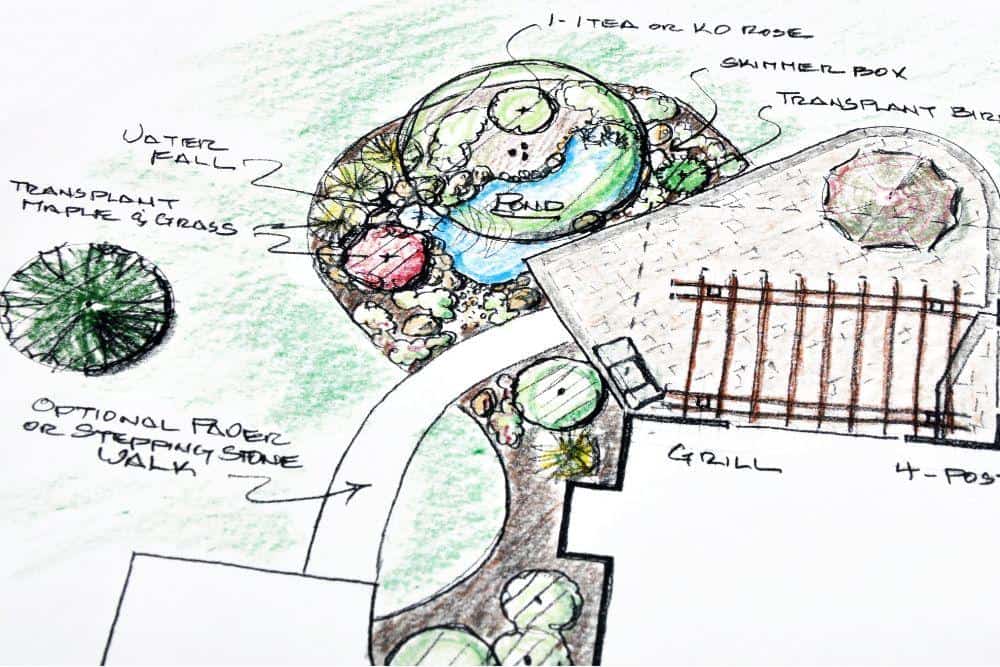Need to know how to write a bid for a landscaping job? Several factors go into creating a proposal for a landscaping job. Luckily, there are resources that can help.
To write a reasonable but profitable proposal with all the correct details, read this comprehensive guide to writing a bid for a landscaping job.

A Lot Goes Into a Properly Constructed Landscaping Bid
Before diving into the considerations, you must understand the definition and precise purpose of a landscaping bid. Bids must contain two crucial pieces of information:
A bid is slightly different from an estimate. An estimate approximates what the client wants and how much it could cost.
But a bid is more detailed and accurate than an estimate or quote. So when submitting a landscaping proposal, ensure you provide a number as accurately as possible for the client.
Many costs go into a landscaping project, and you must consider all expenses when writing a proposal. If you neglect to consider certain project elements, you may underestimate and lose profits or upset your client.
When you price a landscaping job, keep the following considerations in mind.
Labor is one of the most substantial costs in your bid - in many cases it is the most expensive part of a landscaping job. Clients are paying you for the skills and experience they do not have, as well as the time and effort. Calculating labor when you have employees is easier than when you are a solo landscaping contractor.
Calculating your labor will be based on your goal salary for yourself after business expenses. Consider if you could be making more money elsewhere, and make sure you place a bid worth your time.

Properly Calculating Your Labor Costs and Adding Enough Profit Margin is Essential
When charging for labor, meaning the effort you exert doing the project, you have two options. You can price it hourly, making the final cost more flexible. Or you can choose fixed rates for the labor, meaning no matter how long it takes, the labor cost will not change.
A fixed rate may be more comfortable for your clients. Neither option is wrong, so you must choose the labor rate you think works best.
Your timeline will be less of an issue if you plan to charge labor at an hourly rate. But if you use a fixed rate, you need t map out a timeline to help you decide on the labor cost.
In addition to the time spent physically working on the landscaping job, you also need to consider material availability, seasons and weather, other projects at the property, and similar factors that may extend the project length.
If you have to buy or rent specific equipment for the job, you need to factor this into your bid number. Equipment may mean large items like excavators or small things like hand tools.
You can also factor the wear and tear of your equipment into the final cost. The wear on your equipment falls under overhead costs, discussed in more detail later in this article.
Another cost to factor into your bid is the materials you will need. Landscaping project materials may include mulch, sod, gravel, paving stones, ground cover, flowers, soil, and any other items needed.
It can be difficult to determine the exact materials you need for a project, but you must try your best to present an accurate bid to your potential client.
As mentioned, overhead costs are a consideration too. Overhead costs are any consistent costs that you can’t attribute to a single job but are general business expenses.
Examples of overhead costs include building rent, vehicle rent, leases, depreciation of assets (like equipment), utilities, gas, accounting expenses, company insurance, and similar expenses.
You must factor overhead costs into every project bid or estimate to ensure you profit from your landscaping services. Neglecting to include overhead can lead to substantial lost profits.
Sometimes clients present a budget to landscaping contractors, hoping to encourage bids within a determined range. If the client's budget is within reason, keep it in mind while writing your bid.
For example, if the client presents a $10k budget, but you need to charge $25k to make a profit, you may not want to bother bidding. On the other hand, if the budget is $10k, and you need $9k to make a profit, charging $11k or $12k can be a good move.

Be Certain That You Have Properly Laid Out All Client Requirements for Your Landscaping Job
You may also want to think about if the client may become a long-term customer. A commercial client may be able to offer you plenty of jobs in the future or a long-term commercial lawn care contract, giving you a decent reason to lower your bid slightly.
The project specifics are also important. A large commercial landscaping job can put your company on the map, helping you reach more clients and garner an excellent reputation. These are potential reasons to lower your bid, but some project specifics mean you should raise your proposal price.
If the project is particularly intricate or complex, you may want to charge more. For example, a landscaping company may increase its bid if water features or finicky plants are involved. In contrast, a simple lawn mowing job would not require additional fees.
When you price landscaping jobs, how in-demand your services are should be a consideration. If you get offers for landscaping jobs every day and have consistent work and clients to rely on, you can write a larger bid.
On the other hand, if you’re struggling to get landscaping jobs and find clients, lowering your bid gives you a better chance of landing the project. Essentially, how eager you are for the job should play a factor in your pricing.
Another aspect to consider is your reputation and quality standards. If you are a new landscape contractor or company, you may want to bid lower so you can build a client base and create a positive reputation. But if you have been landscaping for years and have an established reputation in the industry, you can charge more.
When you’ve proven yourself as a quality landscaper, you can submit higher bids and price landscaping jobs according to your reputation. If you’re brand new and bidding against veterans in the industry, lowering your price may give you an edge over your experienced competition.
Achieving the ideal profit margin is a balancing act between keeping your prices reasonable and keeping your business profitable.
When first starting your landscaping business, you don't want to aim too high. Trying to achieve a higher profit margin when first starting can make it difficult to land jobs and create a client base.
Most landscaping businesses maintain a profit margin between 10% and 50%. Geographical location is a significant factor in landscaping profit margins.
For example, desert locations like Nevada or Arizona have fewer landscaping opportunities, so the profit margins are often smaller. But areas with wealthy suburban communities full of grass and greenery are likely to have higher profit margins in this industry.
Understanding what your competition charges can help you write your landscaping bids more appropriately. Remember, it’s okay to increase your prices as your company grows and services expand. But starting low can help you get a foothold in the industry and make enough money to continue running your business.
A comprehensive landscaping bid will include the project design, a list of materials, details of labor and equipment, an estimated timeline, a projected budget, and a landscaping contract. Writing your first landscaping bid can be daunting. Luckily, you can use free online templates!
A landscaping proposal template is a brilliant tool for new landscaper contractors and companies. Below are a few convenient resources where you can find and download landscaping proposal templates to make things easier:
Along with your detailed proposal, you can also include a landscaping contract. There are templates for that too! Below are a few places you can get free landscaping contract templates:
Below are the steps for how to write a bid for a landscaping job so you know exactly how to go about creating a proposal and determining the cost.
